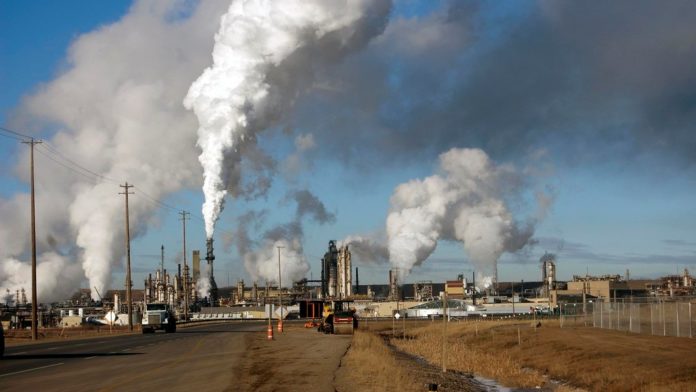New research conducted by federal scientists suggests that greenhouse gas (GHG) emissions from the Alberta oilsands may be higher than what has been reported by the industry, prompting questions over whether standard calculations for reporting actually cover all sources.
Hundreds of air samples were collected by researchers during 17 airplane flights over four major oilsand operations in the province. Their results showed that, on average, actual measured CO2 emissions are 64% higher than recorded in industrial reports, which were put together using the industry standard UN reporting framework for measuring emissions.
One facility — Syncrude Mildred Lake — was found to have 123% higher emissions than what was reported.
The UN reporting framework is also known as the ‘bottom-up’ approach. Measurements are taken at ground-level based on fuel usage at all sources and are then combined with complex mathematical modelling. Activities such as mining and resource processing are accounted for in this approach, but its accuracy is far from certain given the complexity of the facilities and the many variables involved.
“You need to know the type of fuel combusted because different fuels use more or less carbon,” said lead author John Liggio in an interview with the CBC. “There could be non-combustion sources like tailing ponds. There’s a number of other things such as the maintenance for example — a possibility that doing the maintenance causes increases in emissions for short periods. It’s not a simple calculation.”
Liggio also reaffirmed a point made in the paper that there is no reason to believe the industry has manipulated data. “They’re just doing exactly what they’ve been told to do. They’re not doing anything on purpose,” says Liggio.
The ‘top-down’ approach, taken by the federal scientists, involves measuring atmospheric GHG concentrations coupled with inversion models.
Major issues for Paris accord commitments if results can be verified
If these preliminary results are legitimate, the consequences for the nation’s total greenhouse emissions are stark — our total GHG emissions would be 2.3% higher than previously measured. If the other oil sands sites are similarly underreported, this figure could rise to 6%, which would undermine current federal emissions strategies such as the target agreed under the Paris accord.
“The objective of limiting the increase in global temperature to <1.5 °C this century is dependent upon reducing anthropogenic GHG emissions to net zero,” say the authors. “The large contribution of the oil and gas sector to global GHG emissions underscores the need for accurate sectoral GHG emissions in national inventories.”
Although industry representatives declined a request for a comment by the National Observer, the office of the Environmental and Climate Change Minister Catherine McKenna said that “while this is just one study, we are taking these findings seriously and will be reviewing them in light of Canada’s commitment to fight climate change and build a stronger economy.”
The office also confirmed that Canada would continue assessing GHG measurements according to the ‘bottom-up’ method for the foreseeable future.
But there’s more work to be done to cover more potential operation scenarios. None of the oilsand operations examined in this study involve in-situ extraction, which involves pumping high-pressure steam into the ground to access petroleum and makes up 80% of all extraction in Alberta. The team are currently examining emissions data from other sites including around 10 in situ sites to further investigate the situation.








































